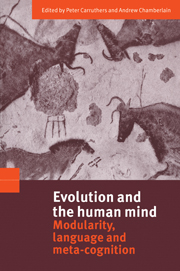Book contents
- Frontmatter
- Contents
- List of contributors
- Preface
- 1 Introduction
- 2 Massively modular minds: evolutionary psychology and cognitive architecture
- 3 Individual differences in early understanding of mind: genes, non-shared environment and modularity
- 4 Darwin in the madhouse: evolutionary psychology and the classification of mental disorders
- 5 Evolution of the modern mind and the origins of culture: religious concepts as a limiting-case
- 6 Symmetry and the evolution of the modular linguistic mind
- 7 Evolution, communication and the proper function of language
- 8 The evolution of knowledge
- 9 Mind, brain and material culture: an archaeological perspective
- 10 The evolution of strategic thinking
- 11 On the origin of the human mind
- 12 The evolution of consciousness
- 13 Evolution, consciousness and the internality of the mind
- References
- Author index
- Subject index
9 - Mind, brain and material culture: an archaeological perspective
Published online by Cambridge University Press: 18 December 2009
- Frontmatter
- Contents
- List of contributors
- Preface
- 1 Introduction
- 2 Massively modular minds: evolutionary psychology and cognitive architecture
- 3 Individual differences in early understanding of mind: genes, non-shared environment and modularity
- 4 Darwin in the madhouse: evolutionary psychology and the classification of mental disorders
- 5 Evolution of the modern mind and the origins of culture: religious concepts as a limiting-case
- 6 Symmetry and the evolution of the modular linguistic mind
- 7 Evolution, communication and the proper function of language
- 8 The evolution of knowledge
- 9 Mind, brain and material culture: an archaeological perspective
- 10 The evolution of strategic thinking
- 11 On the origin of the human mind
- 12 The evolution of consciousness
- 13 Evolution, consciousness and the internality of the mind
- References
- Author index
- Subject index
Summary
The fossil record for human evolution has provided a detailed picture for the course of brain enlargement from the c. 400cc brain size of early australopithecines at around 3.5 million years ago to the c. 1200–1500cc of modern humans. I discuss the relationship between this and the evolution of the human mind, arguing that neither brain size alone, nor arguments about changing networks within the brain, are sufficient to explain the patterns we can infer from the archaeological record about the development of human intelligence. The key event in the evolution of the modern mind appears to be when humans began to extend their minds by exploiting not just language, but also material culture and their social structures, as means of augmenting the mental capacities delivered by the brain alone.
Introduction
The last decade has seen a remarkable surge of interest in the evolution of the mind. This has arisen within a wide range of disciplines and been fostered by a considerable degree of inter-disciplinary cross-fertilisation at conferences and within edited publications (e.g. Barkow et al., 1992; Mellars and Gibson, 1996; Mithen, 1996b; Noble and Davidson, 1996; Bock and Cardew, 1997; Pinker, 1997b; Crawford and Krebs, 1998). Each discipline has, of course, a unique contribution to make to our understanding of cognitive evolution – psychologists bring to this topic a specialised understanding of modern minds, while neuroscientists, armed with their latest brain scanners, seek to extend our understanding of how the brain works. Archaeology has the benefit of being able to study the behaviour of human ancestors and relatives.
- Type
- Chapter
- Information
- Evolution and the Human MindModularity, Language and Meta-Cognition, pp. 207 - 217Publisher: Cambridge University PressPrint publication year: 2000
- 14
- Cited by



